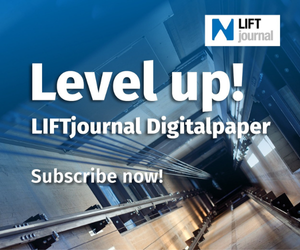News from the world of standardisation
The drafts of EN ISO 8100-1/2 have appeared. They are now available as pr DIN EN ISO 8100-1 and pr DIN EN ISO 8100-2. A brief of overview of the changes compared to DIN EN 81-20/50.
By Jan König
The two standards involve lifts for passenger and goods transport. Part 1 deals with safety regulations for the design and installation of passenger and goods lifts, Part 2 with the design regulations, calculations and testing of lift components.
The drafts EN ISO 8100-1/2:2023 were published by the International Organization for Standardization (ISO) in September 2023, with the February 2024 issue they were implemented nationally as drafts DIN EN ISO 8100-1/2:2024. They are the replacement for DIN EN 81-20/50:2020-06.
Part 1: Safety rules for the construction and installation of passenger and goods lifts
Part 1 includes safety-related specifications according to Annex I of the EU Machinery Directive 2006/42/EC. This is intended to simplify proof of the correspondence with these requirements.
This document specifies the safety rules for lifts permanently installed in buildings, which are intended to transport passengers or passengers and goods. It is applicable to:
- lifts with traction sheaves, drum- or hydraulic drives;
- lifts that serve fixed levels;
- lifts with closed cars;
- lifts that move along guide rails that are not inclined more than 15° to the vertical;
- lifts installed in buildings with boundary conditions according to Annex B;
- the electrical equipment of lifts, including lighting and plug sockets in the shaft.
The draft does not specify any additional requirements on:
- lifts installed in buildings with requirements under earthquake conditions;
- lifts installed in buildings with requirements on accessibility;
- lifts exposed to wanton destruction;
- lifts intended for fire service deployments;
- lifts intended exclusively for the transport of goods in which the load carrier is accessible and equipped with controls within the load carrier or within reach of a passenger inside the load carrier;
- the behaviour of the lift if the lift controller receives one or more recall signals in the event of a fire in the building.
The document does not apply to passenger and goods lifts erected before its publication.
Changes
DIN EN 81-20:2020-06 was adopted as pr DIN EN ISO 8100-1 and fundamentally revised.
What has changed compared to DIN EN 81-20:2020-06?
- Document transformed into an international standard;
- Editorial overhaul of the document structure;
- Requirements on vertically-moving landing and car sliding doors;
- Requirements for lifting gear that are not steel ropes;
- Requirements for automatic emergency rescue;
- Requirements for traction lifts with increased useful floor space of the car;
- Requirements for switches with SIL classification (previously termed PESSRAL)
- Requirements for a movable platform in the shaft pit;
- Requirements to prevent trapping of hands in doors;
- Requirements for the means of compensation that extend to the safety area in the shaft pit;
- Requirements for the brake with the overload values;
- Performance and monitoring of the drive brake;
- Requirements for ladders for access to the shaft pit;
- Classification of the fire behaviour of electrical lines.
Part 2: Design rules, calculations and tests of lift components
Part 2 also includes safety-related specifications according to Annex I of the EU Machinery Directive 2006/42/EC. Here too, the aim is to simplify proof of the correspondence with these requirements.
The draft lays down the following for passenger and goods lifts:
- checking door locks;
- checking safety gear;
- checking speed governors;
- checking buffers;
- checking safety switches and switches with SIL classification;
- checking the safety installation for upward-travelling cars against overspeed;
- checking the safety installation for unintended car movement;
- checking valve line breakage valves and throttle check valves;
- checking means of suspension and compensation;
- replacement criteria for means of suspension and power transmission contact;
- calculation of guide rails;
- calculation of pistons, cylinders, fixed pipes and fittings;
- determination of traction;
- determination of safety coefficient of means of suspension;
- pendulum impact tests;
- fault exclusion for electrical and electronic components;
- design rules for switches with SIL classification.
The document does not apply to passenger and goods lifts or components of lifts erected before its publication.
Changes
DIN EN 81-50:2020-06 was adopted as pr DIN EN ISO 8100-2 and fundamentally revised.
These are the changes compared to DIN EN 81-50:2020-06:
- document transformed into an international standard;
- editorial overhaul of the document structure;
- mechanical tests and temperature tests of safety switches and switches with SIL classification were updated;
- errors in the equations for the calculation of traction capacity were corrected;
- verification methods for other means of suspension and compensation than steel ropes were added;
- replacement criteria for means of suspension and power transmission contact were added;
- requirements for switches with SIL classification (previously termed PESSRAL).
The author is the owner of the engineering firm (VDI) Ing4Lifts and is a member of the LIFTjournal Advisory Board.
More information: • Inhaltsverzeichnis Entwurf DIN EN ISO 8100-1:2024
• Entwurf DIN EN ISO 8100-1:2024 beim Beuth
• Inhaltsverzeichnis Entwurf DIN EN ISO 8100-2:2024
• Entwurf DIN EN ISO 8100-2:2024 beim Beuth
• Technisches Komitee CEN/TC 10 "Aufzüge, Fahrtreppen und Fahrsteige"
• Technisches Komitee ISO/TC 178 "Aufzüge, Fahrtreppen und Fahrsteige"


























2 Kommentare
Write a comment